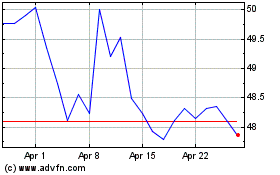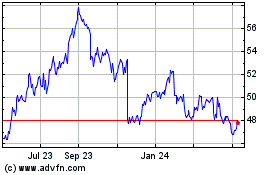Cisco Study Reveals Very Few Organizations in Canada Prepared to Defend Against Today's Rapidly Evolving Threat Landscape
27 March 2024 - 9:00PM

Only one per cent of organizations in Canada have the ‘Mature’
level of readiness needed to be resilient against modern
cybersecurity risks, according to Cisco’s (NASDAQ: CSCO) 2024
Cybersecurity Readiness Index.
The 2024 Cisco Cybersecurity Readiness Index was
developed in an era defined by hyperconnectivity and a rapidly
evolving threat landscape. Companies today continue to be targeted
with a variety of techniques that range from phishing and
ransomware to supply chain and social engineering attacks. And
while they are building defenses against these attacks, they still
struggle to defend against them, slowed down by their own overly
complex security postures that are dominated by multiple point
solutions.
These challenges are compounded in today’s
distributed working environments where data can be spread across
limitless services, devices, applications, and users. However, 78
per cent of Canadian companies still feel moderately to very
confident in their ability to defend against a cyberattack with
their current infrastructure. This disparity between confidence and
readiness suggests that companies may have misplaced confidence in
their ability to navigate the threat landscape and may not be
properly assessing the true scale of the challenges they face.
“We cannot underestimate the threat posed by our own
overconfidence,” said Jeetu Patel, Executive Vice President and
General Manager of Security and Collaboration at Cisco. “Today's
organizations need to prioritize investments in integrated
platforms and lean into AI in order to operate at machine scale and
finally tip the scales in the favor of defenders.”
2024 Cisco Cybersecurity Readiness
Index: Underprepared and Overconfident Companies Tackle an Evolving
Threat Landscape
The Index assesses the readiness of companies on
five key pillars: Identity Intelligence, Network
Resilience, Machine Trustworthiness, Cloud Reinforcement,
and AI Fortification, which are comprised of 31
corresponding solutions and capabilities. It is based on a
double-blind survey of more than 8,000 private sector security and
business leaders across 30 global markets conducted by an
independent third party. The respondents were asked to indicate
which of these solutions and capabilities they had deployed and the
stage of deployment. Companies were then classified into four
stages of increasing readiness: Beginner, Formative,
Progressive and Mature.
“The threats we face today will not be the same
ones we face tomorrow so Canadian businesses need to evolve to keep
up,” said Robert Barton, Chief Technology Officer, Cisco Canada.
“The material, financial and reputational consequences can have a
serious impact on organizations so cybersecurity readiness must be
a business priority, not just a technological one.”
Findings
Overall, the study found that only one
per cent of companies in Canada are ready to tackle today’s
threats, with 78 per cent of organizations falling into
the Beginner or Formative stages of readiness. Globally, 3 per cent
of companies are at a Mature stage. Further:
- Future Cyber Incidents
Expected: 63 per cent of respondents said they expect a
cybersecurity incident to disrupt their business in the next 12 to
24 months. The cost of being unprepared can be substantial, as 43
per cent of respondents said they experienced a cybersecurity
incident in the last 12 months, and 46 per cent of those affected
said it cost them at least US$300,000.
- Point Solution
Overload: The traditional approach of adopting multiple
cybersecurity point solutions has not delivered effective results,
as 72 per cent of respondents admitted that having multiple point
solutions slowed down their team’s ability to detect, respond and
recover from incidents. This raises significant concerns as 62 per
cent of organizations said they have deployed ten or more point
solutions in their security stacks, while 17 per cent said they
have 30 or more.
- Unsecure and Unmanaged
Devices Add Complexity: 78 per cent of companies said
their employees access company platforms from unmanaged devices,
and 33 per cent of those spend one-fifth (20 per cent) of their
time logged onto company networks from unmanaged devices.
Additionally, 20 per cent reported that their employees hop
between at least six networks over a week.
- The Cyber Talent Gap
Persists: Progress is being further hampered by critical
talent shortages, with 83 per cent of companies highlighting it as
an issue. In fact, 35 per cent of companies said they had more than
ten roles related to cybersecurity unfilled in their organization
at the time of the survey.
- Future Cyber Investments
Ramping Up: Companies are aware of the challenge and are
ramping up their defenses with 40 per cent planning to
significantly upgrade their IT infrastructure in the next 12 to 24
months. This is a marked increase from just 25 per cent who planned
to do so last year. Most prominently, organizations plan to upgrade
existing solutions (67 per cent), deploy new solutions (53 per
cent), and invest in AI-driven technologies (50 per cent). Further,
96 per cent of companies expect to increase their cybersecurity
budget in the next 12 months, and 78 per cent of respondents say
their budgets will increase by 10 per cent or more.
To overcome the challenges of today’s threat landscape,
companies must accelerate meaningful investments in security,
including adoption of innovative security measures and a security
platform approach, strengthen their network resilience, establish
meaningful use of generative AI, and ramp up recruitment to bridge
the cybersecurity skills gap.
Additional Resources:
- 2024 Cybersecurity Readiness Index
Overview and Reports
About
Cisco Cisco (NASDAQ: CSCO) is the worldwide
technology leader that securely connects everything to make
anything possible. Our purpose is to power an inclusive future for
all by helping our customers reimagine their applications, power
hybrid work, secure their enterprise, transform their
infrastructure, and meet their sustainability goals. Discover more
on The Newsroom and follow us on X at @Cisco.
Cisco and the Cisco logo
are trademarks or registered trademarks of Cisco and/or its
affiliates in the U.S. and other countries. A listing of Cisco's
trademarks can be found at www.cisco.com/go/trademarks. Third-party
trademarks mentioned are the property of their respective owners.
The use of the word partner does not imply a partnership
relationship between Cisco and any other company.
Cisco Systems (NASDAQ:CSCO)
Historical Stock Chart
From Dec 2024 to Jan 2025

Cisco Systems (NASDAQ:CSCO)
Historical Stock Chart
From Jan 2024 to Jan 2025
